Indiana’s avian landscape is adorned with the presence of seven distinctive woodpecker species, each contributing to the state’s biodiversity and ecological balance.
From the vibrant Pileated Woodpecker to the industrious Red-bellied Woodpecker, these birds bring both visual splendor and functional significance to Indiana’s woodlands.
This diverse array of woodpeckers showcases the resilience and adaptability of these feathered inhabitants in different ecosystems across the state.
As integral components of Indiana’s ecosystems, these woodpeckers play a vital role in controlling insect populations and maintaining the health of the forests.
Join us to explore Indiana’s woodpecker wonders, delving into the unique characteristics and behaviors that make each species a valuable contributor to the dynamic tapestry of the Hoosier State’s birdlife.
Common Characteristics of Woodpeckers of Indiana
Woodpeckers in Indiana share common characteristics that define their adaptability and unique role in the state’s ecosystems. Here are six descriptive points illuminating these traits:
Specialized Beak Structure
Woodpeckers possess strong, chisel-like beaks designed for excavating wood. This specialized structure enables them to drill into tree bark in search of insects and create nesting cavities.
Distinctive Plumage Patterns
Many Indiana woodpecker species exhibit striking plumage patterns, often featuring bold contrasts and vibrant colors. This serves both functional and ornamental purposes, aiding in species recognition and courtship displays.
Zygodactyl Feet
Woodpeckers have zygodactyl feet, with two toes pointing forward and two backward. This unique foot structure provides a secure grip on vertical surfaces, allowing them to cling to tree trunks while foraging.
Strong Neck Muscles
To withstand the force of repeated pecking, woodpeckers have robust neck muscles and a specialized skull structure. These adaptations protect their brains from the impact of rapid drilling.
Drumming Behavior
Woodpeckers engage in drumming behavior, producing rhythmic tapping sounds on trees to communicate with each other and establish territory. Each species may have its distinct drumming pattern.
Insectivorous Diet
Woodpeckers primarily feed on insects found beneath the bark of trees. Their foraging activities contribute to pest control in forests, helping maintain the ecosystem’s overall health.
Woodpeckers of Indiana
Indiana’s woodlands resonate with seven unique woodpecker species’ rhythmic taps and vibrant plumage.
From the striking Pileated Woodpecker to the resilient Red-bellied Woodpecker, these avian residents contribute to the rich biodiversity and ecological balance of the Hoosier State.
1. Downy Woodpecker

- Scientific Name: Picoides pubescens
- Category: Woodpecker
- Population: Common and Stable
- Life Span: 4 to 6 years
- Size: 5.5 to 7 inches
- Weight: 0.7 to 1.0 ounces
- Food: Insects, seeds, and berries
- Wingspan: 9.8 to 12.2 inches
- Status: Least Concern
The Downy Woodpecker, the smallest and most common woodpecker in Indiana, thrives in various habitats, including forests, woodlots, and suburban areas.
Recognizable by its black and white plumage, this woodpecker is an adept climber, using its zygodactyl feet to navigate tree trunks easily.
The Downy Woodpecker contributes to pest control with a diet comprising insects, seeds, and berries. These charming birds are known for their drumming behavior, producing rapid, rhythmic beats on trees to communicate and establish territory.
Their nests, often excavated in dead trees or limbs, play a crucial role in the woodland ecosystem, providing shelter for various small creatures.
Despite their diminutive size, Downy Woodpeckers are resilient and adaptable, making them a delightful and enduring presence in Indiana’s avian landscape.
2. Hairy Woodpecker
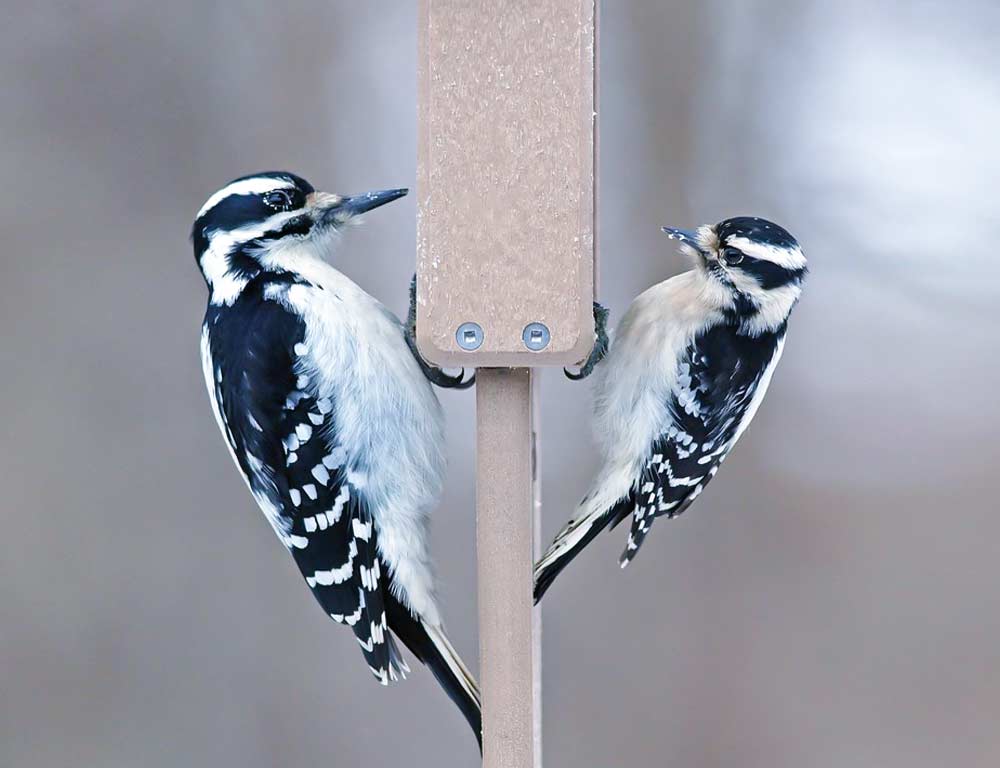
- Scientific Name: Leuconotopicus villosus
- Category: Woodpecker
- Population: Stable
- Life Span: 4 to 6 years
- Size: 7 to 10 inches
- Weight: 1.4 to 3.4 ounces
- Food: Insects, seeds, and berries
- Wingspan: 13 to 17 inches
- Status: Least Concern
The Hairy Woodpecker, a close relative of the Downy, shares similar characteristics but is larger in size. With striking black and white plumage and a long, sturdy bill, they are often found in mature forests and wooded areas throughout Indiana.
Their drumming sounds, echoing through the woods, are a distinctive feature during the breeding season.
Hairy Woodpeckers are skilled foragers, using their strong bills to extract insects from tree bark and probe for hidden larvae. Their adaptability allows them to thrive in various environments, from dense forests to open woodlands.
Creating nests in cavities, these woodpeckers contribute to the ecosystem’s health by controlling insect populations and providing nesting sites for other bird species.
3. Pileated Woodpecker
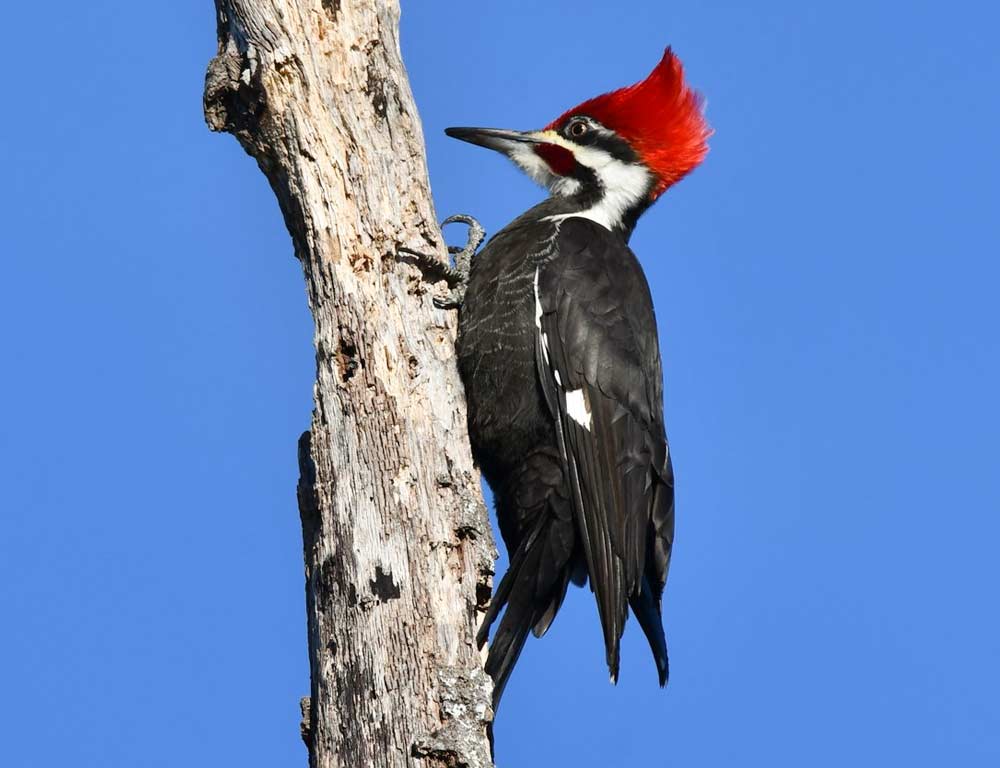
- Scientific Name: Dryocopus pileatus
- Category: Woodpecker
- Population: Stable
- Life Span: 7 to 10 years
- Size: 16 to 19 inches
- Weight: 8 to 12 ounces
- Food: Insects, fruits, and tree-dwelling ants
- Wingspan: 26 to 30 inches
- Status: Least Concern
The Pileated Woodpecker, an impressive and iconic species, is the largest woodpecker in Indiana.
With its striking black and white plumage and a distinctive red crest, these birds are often found in mature forests with ample dead wood.
Pileated woodpeckers are skilled carpenters who excavate large rectangular cavities in trees for nesting and foraging.
Known for their loud calls and drumming sounds, Pileated Woodpeckers are territorial and communicate effectively within their habitat.
Their diet includes insects, fruits, and tree-dwelling ants, and their foraging activities contribute to the overall health of the forest ecosystem.
Despite their size, these woodpeckers are agile flyers, gracefully navigating through the forest canopy. As integral components of Indiana’s woodlands, Pileated Woodpeckers play a vital role in shaping the state’s diverse avian community.
4. Yellow-bellied Sapsucker
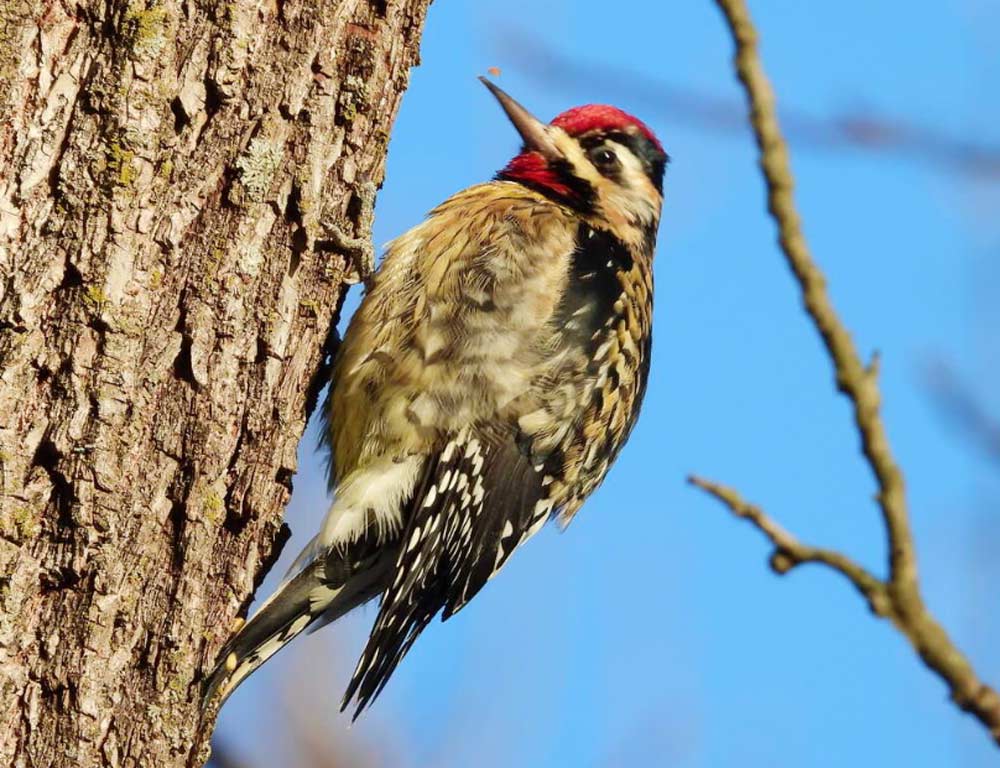
- Scientific Name: Sphyrapicus varius
- Category: Woodpecker
- Population: Stable
- Life Span: 4 to 6 years
- Size: 7 to 8.75 inches
- Weight: 1.6 to 2.8 ounces
- Food: Tree sap, insects, fruits
- Wingspan: 13 to 15.75 inches
- Status: Least Concern
Yellow-bellied Sapsuckers are unique woodpeckers known for their feeding habits. They drill shallow holes in tree bark, creating sap wells to feed on the sap that oozes out.
These birds have a distinct black and white plumage with a red crown and a yellow wash on their belly. Their feeding strategy attracts insects, making them an important part of the ecosystem’s balance.
These woodpeckers are often found in mixed woodlands, particularly favoring deciduous trees. During the breeding season, they intensify their drumming and calls, contributing to the forest’s auditory landscape.
Their role as sap feeders and insect consumers highlights their ecological importance in Indiana’s diverse habitats.
5. Red-bellied Woodpecker
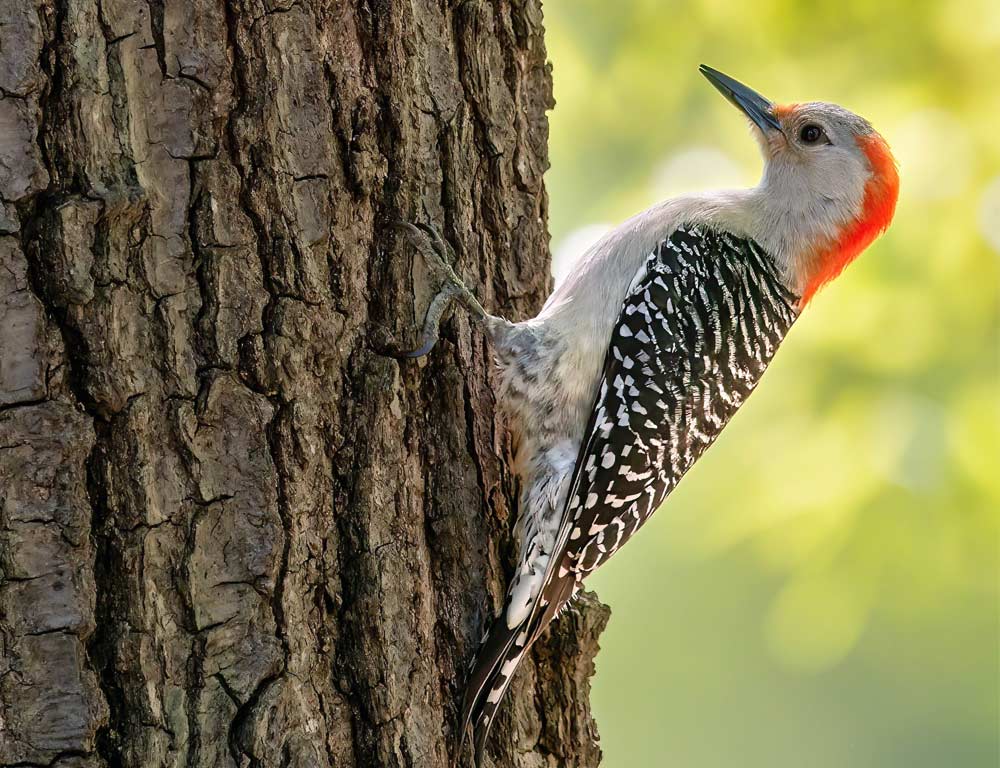
- Scientific Name: Melanerpes carolinus
- Category: Woodpecker
- Population: Abundant
- Life Span: 9 to 12 years
- Size: 9.25 to 10.5 inches
- Weight: 2 to 3.2 ounces
- Food: Insects, fruits, seeds, and nuts
- Wingspan: 13 to 16.5 inches
- Status: Least Concern
Contrary to its name, the Red-bellied Woodpecker has a reddish wash on its belly, often more subtle than the vibrant red cap on its head.
This species is adaptable and commonly found in various habitats, including woodlands, parks, and suburban areas throughout Indiana.
Red-bellied Woodpeckers have a diverse diet, consuming insects, fruits, seeds, and nuts. They are known for their ability to store food in crevices and tree bark, aiding them during harsh weather conditions.
These woodpeckers are vocal, with various calls and drumming sounds used for communication and territorial defense. Their versatility and resilience make them a charismatic and prevalent presence in Indiana’s birdlife.
6. Northern Flicker
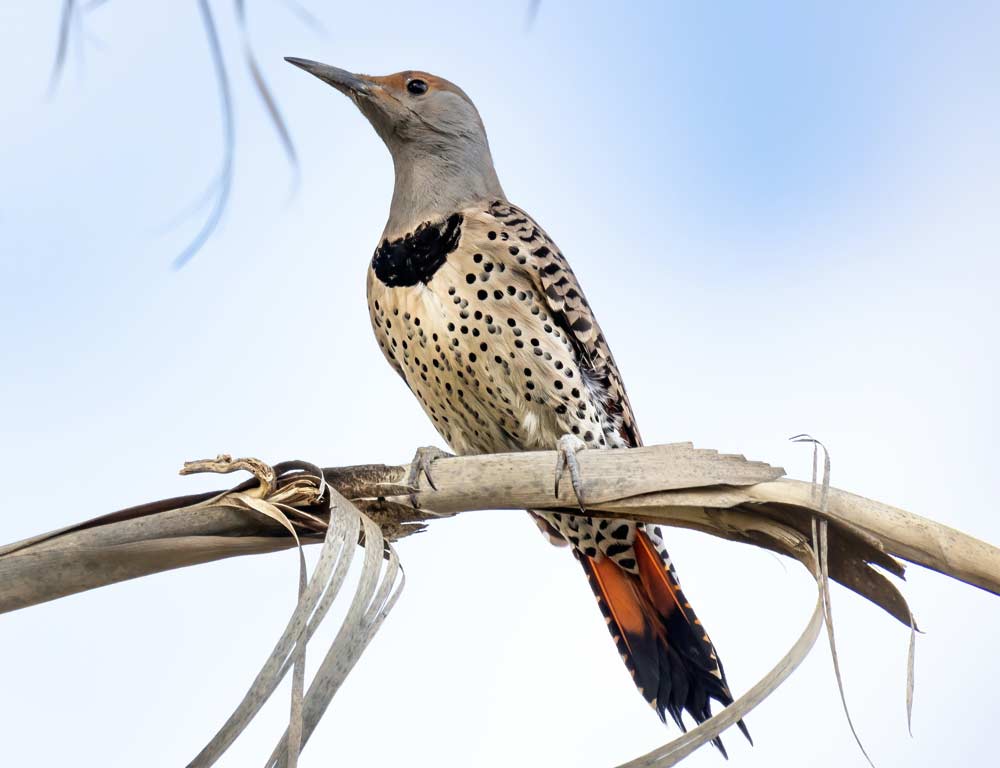
- Scientific Name: Colaptes auratus
- Category: Woodpecker
- Population: Stable
- Life Span: 6 to 9 years
- Size: 11 to 14 inches
- Weight: 3 to 5.9 ounces
- Food: Insects, ants, berries, seeds
- Wingspan: 16.5 to 20 inches
- Status: Least Concern
Northern Flickers, a distinctive woodpecker species, exhibit unique characteristics. They are easily recognizable with a beige and brown plumage adorned with black bars, a spotted belly, and a red nape crescent.
Their habitat preference includes open woodlands, grasslands, and urban areas.
Unlike traditional woodpeckers, Northern Flickers primarily feed on the ground, using their slightly curved bill to probe for insects and ants. They are proficient at catching insects in flight and also consume berries and seeds.
Their drumming sounds are less intense than other woodpeckers, and their vibrant plumage and ground-feeding behavior contribute to their ecological niche in Indiana’s diverse landscapes.
7. Red-headed Woodpecker
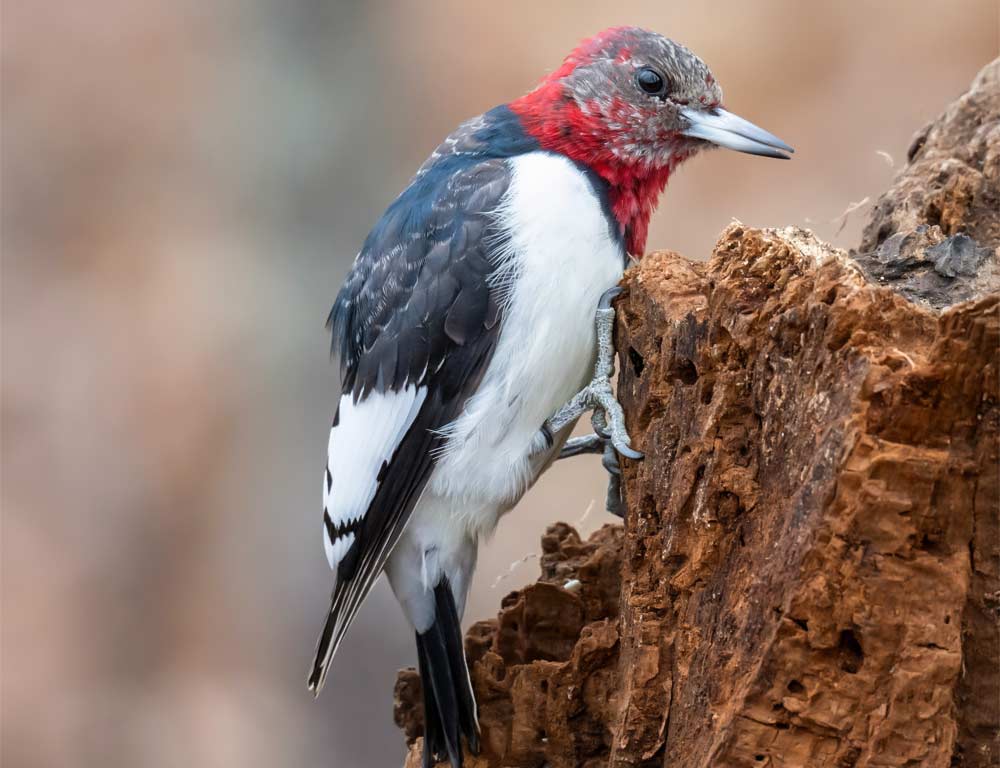
- Scientific Name: Melanerpes erythrocephalus
- Category: Woodpecker
- Population: Declining
- Life Span: 9 to 12 years
- Size: 7.5 to 9.25 inches
- Weight: 2.2 to 3.2 ounces
- Food: Insects, fruits, nuts
- Wingspan: 16.5 to 17 inches
- Status: Near Threatened
The Red-headed Woodpecker is a striking species with a vibrant redhead, contrasting black and white plumage, and a distinctive entirely red belly.
Unfortunately, their population is declining due to habitat loss and competition for nesting sites.
These woodpeckers are adept at catching insects in mid-air and storing them in crevices or tree bark. They also consume fruits and nuts, showcasing a varied diet.
Known for their acrobatic flight and vibrant appearance, Red-headed Woodpeckers play a crucial role in seed dispersal and insect control. Conservation efforts are vital to ensure the survival of this charismatic species in Indiana’s ecosystems.
How to Preserve Woodpeckers of Indiana?
Preserving woodpeckers in Indiana involves a combination of habitat conservation, sustainable practices, and community awareness. Here are key strategies:
Habitat Protection
Identify and preserve crucial woodpecker habitats, including mature forests, woodlots, and urban green spaces.
Establish and maintain wildlife corridors to ensure connectivity between fragmented habitats, promoting genetic diversity among woodpecker populations.
Nest Box Programs
Implement and support nest box programs designed specifically for woodpeckers, offering artificial nesting sites in areas where natural cavities may be scarce.
Biodiversity Promotion
Encourage planting native trees and vegetation that provide food sources for woodpeckers, supporting a diverse insect population and enhancing overall ecosystem health.
Reduce Pesticide Use
Advocate for reduced pesticide use in woodpecker habitats to protect their insect prey and prevent the accumulation of harmful chemicals in the environment.
Education and Outreach
Raise public awareness about the importance of woodpeckers in maintaining ecological balance.
Provide educational programs to communities, schools, and nature enthusiasts, emphasizing responsible birdwatching practices and the significance of preserving woodpecker habitats.
Collaboration with Conservation Organizations
Support and collaborate with conservation organizations working on woodpecker preservation initiatives. Participate in citizen science projects that monitor woodpecker populations and contribute valuable data for conservation efforts.
Forest Management Practices
Implement sustainable forest management practices that balance woodpecker habitats and other land uses. Avoid excessive logging in areas critical for woodpecker nesting and foraging.
By combining these strategies, Indiana can foster a conducive environment for woodpeckers, ensuring their continued presence and contributing to the state’s overall biodiversity and ecological health.
Wrapping Up
Indiana’s woodpeckers carve an essential niche in the state’s avian tapestry in the rhythmic tap of their beaks and the vibrant hues of their plumage.
Each species contributes to the dynamic balance of Indiana’s ecosystems, from the acrobatic Red-headed Woodpecker to the ground-foraging Northern Flicker.
Their diverse habitats, distinctive behaviors, and vital roles in pest control underscore the significance of these charismatic birds in the Hoosier State.
As stewards of our natural heritage, we are responsible for appreciating, conserving, and safeguarding the habitats that sustain these woodpeckers, ensuring their enduring presence in Indiana’s woodlands.